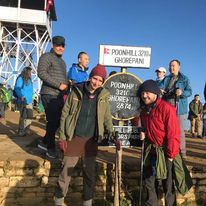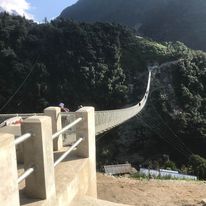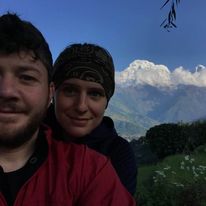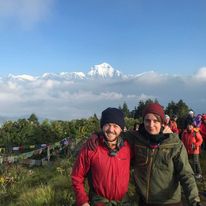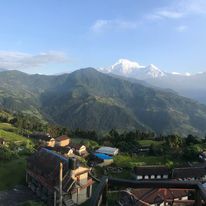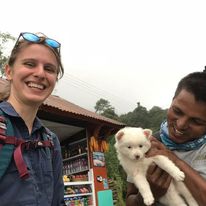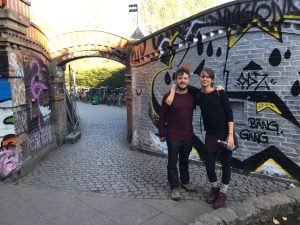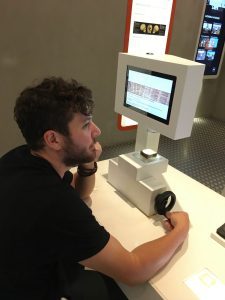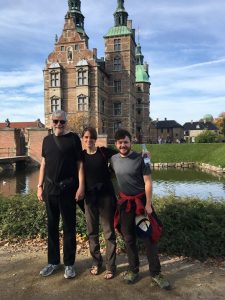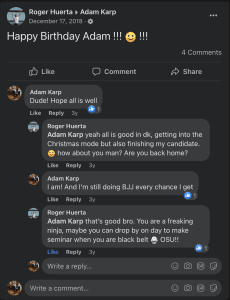Treat Everyone Like They Will Be A Black Belt
Dust Mop Jiu Jitsu: The Expat Files: Chapter Four: CSA-Copenhagen, Denmark
-On fitting in, reconnecting to nature and BJJ as a communal endeavor
–
This is Chapter 3 of what I’m calling the Expat Files. If you want to know more about what this project is, you can read more about it in the first article here.
–
After Thailand, Rachel and I went to Nepal. I found literally no traces of BJJ existing there. We spent two weeks there trekking and breathing fresh air. This was a detox we sorely needed. Ulsan, the city in Korea, where we had lived, was incredibly crowded. Most nights we had to keep our curtains closed to keep out the neon lights. The first time we slept in our apartment, we heard the screaming cries of a stumbling drunk. But for two weeks in Pokhara, we woke up and saw mountains for days. Missing Jits was honestly worth it.
Rachel’s parents are both academics. Her mom gets consulting jobs all over the world to help museum’s with their exhibits. It’s really impressive because she can tell you all about the cafeteria in each one and what you should be ordering. Right after leaving Nepal, we met up with them in Copenhagen where she was working with the natural history museum.
Copenhagen is a beautiful city with beautiful people. A little…too beautiful maybe. Let me explain. Rachel and I had spent a year where we were, quite obviously, not Korean. People just automatically knew to switch to English when they saw us, or, at the very least not try speaking Korean. We thought that going to Europe would be the end of that but…no. People there all seemed to be a foot taller than me and incredibly stylish. We were planning a backpacking trip in Spain so we only had hiking clothing. But as the Danes rode their bikes through the streets, they all seemed like something out of a Gap commercial only wearing black or charcoal. I swear I saw a woman riding a bike with a scarf on where it waved behind her like a flag. Not a care in the world. No worry, for example, that it would turn into a game of tug of war between her neck and the bike chain. I think most people could tell without speaking to me that I wasn’t a local. I’m too short to be a Dane.
The food was amazing, if not a shock to the system. Good bread is hard to come by in Korea. Most apartments I saw in Ulsan didn’t even have an oven. And cheese options were limited as well. But here we were eating smoked salmon on the richest cheeses and the hartiest breads we’ve ever encountered. I lost a lot of weight in Korea not having access to that stuff. I gained it back in Denmark.
For Jiu Jitsu, I knew exactly where I wanted to go. CSA, home of the BJJ Globetrotters! I knew that was where the whole project of politics-free Jiu Jitsu started. I made sure to get myself over there. One morning, I hopped on what seemed like the world’s most advanced bikeshare and made my way to the class. (Biking in Denmark is awesome, and there are good views everywhere.)
When I arrived I saw a building that looked huge. I knew it couldn’t be 100 percent dedicated to BJJ. It turned out to be a community center with art studios, education offices and gym space. The hallways looked all the same and I wasn’t able to find CSA. I even stopped by a Karate dojo in the building wondering if they shared the mats with them.
Finally, I found the place. They didn’t have a bathroom in the gym space so I went down the hall. It didn’t have a gender on the sign so I went in and saw a room full of doors, each leading to a private toilet. In the middle was the sink with the soap. I went into a toilet stall and changed into my rash guard. When I came out, I saw a woman washing her hands and I was taken aback. Up until that point in my life, I had literally never seen a public restroom set up that way. Why don’t we do that in the US? It would probably save space and make some culture war issues moot. It’s honestly seeing things like Danish bathrooms that make travel worth it.
Roger Huerta was the instructor for the day. He said he was just filling in for the jiu jitsu instructor. Although Adam Shahir Kayoom at Q23 is an MMA fighter, I had never had a class taught by someone who mostly taught striking. But I was intrigued. MMA is an interesting part of the jiu jitsu journey. Before doing BJJ, I had never been interested in the sport at all. But as I learned more about the history of the UFC and the way it brought grappling to the spotlight, I started to gain more perspective. The first UFC I ever made a point to watch had just happened the previous week. It was the infamous UFC 229: Connor McGregor vs. Khabib Nurmagamedov. I had kept my eye on the media hype over it because it felt like the ultimate grappler versus striker setup. I had felt somehow vindicated when Khabib played with McGregor like a cat place with a ball of yarn. My discipline was legit enough to win.
Despite my budding interest in MMA, I was still unsure of what a BJJ class taught by a striker would entail. Roger was the nicest guy. It was me and three Danish guys. I remember one of them being super tall and the other guy being very large. I’ll never forget grappling with the latter and not being able to secure the ever-illusive triangle choke. He said, “Ya don’t worry about it. My neck is too fat. Everybody is telling me so.”
Most Danes I met spoke English better than me so their fluency didn’t really surprise me. Still, what surprised me was that the class was taught entirely in English. It made sense in Thailand since most people were expats. But I still can’t figure out if that’s how they normally do it or if they just switched as soon as I got in the class. Come to think of it, to this day (4/5/22), the last time I’ve been to a Jiu Jitsu class not taught in English was in Korea.
Roger turned out to be a really fascinating person. After the class we had a conversation about life, fulfillment, mental health and training that covered a lot of ground. It felt like the kind of talk you have with a friend over a series of drinks but here we were sober, exhausted and getting into all of life’s mysteries. A few months later, he messaged me on my birthday. Everyone does that on facebook, but his last comment meant a lot to me. He was the first person to suggest that I could someday become a black belt.
If you haven’t seen it, there’s an amazing ted talk called lollipop moments. In it, Drew Dudley advocates for thanking people for offhand comments that make us feel special. Even, or especially, when they can’t remember it themselves.
“We celebrate birthdays, where all you have to do is not die for 365 days. Yet we let people who have made our lives better walk around without knowing it.”
Roger might have just been being nice by suggesting that I might one day become a black belt. But my theory is that longevity in this sport has to be a communal endeavor. The common estimate is that it takes ten years to become a black belt. How can you possibly do that alone?
You need people to care that you stick with it and you need to be invested in their success and longevity as well. People care that I show up on the mats. I have to remember that and care that they show up as well. Treat everyone like they will be a black belt and you might find yourself becoming one faster.
So, this one’s for you Roger. Your prediction was a major lollipop moment.
–
My goal is to visit 100 gyms! If you ever want me to visit yours and write about what it’s like to learn from you, feel free to reach out at Du*************@***il.com.
If you want to read my articles as soon as they’re published, you can follow me here.


